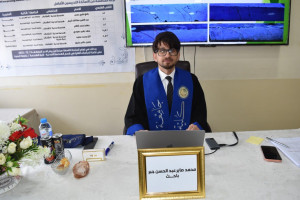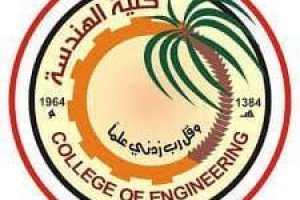
ABSTRACT
Treating oily wastewater is considered one of the most prominent environmental challenges at the present time because it contains high concentrations of resistant pollutants and non-biodegradable compounds. Therefore, adopting innovative technologies to reduce its environmental impact by removing the pollutants that threaten water bodies is an essential requirement. One of the most important of these technologies is the use of advanced oxidation processes within the wastewater treatment plant operation line.
The main objective of this study is to treat oily wastewater generated in the Hamdan Industrial Zone in Basra Governorate, southern Iraq, by integrating advanced oxidation processes (AOPs) within the operating cycle time of the Sequential Batch Reactor (SBR). This aim was implemented via constructing and installing experimental rig for the SBR in Fluid Mechanics Laboratory/ College of Engineering/ University of Basrah. The raw oily wastewater was taken from the equalization tank in the wastewater treatment plant of Hamdan Industrial Zone (the generation source of oily wastewater) and transported to the experimental work site. The considered AOPs include those based on hydrogen peroxide, ozone, ultraviolet radiation, titanium dioxide, and a combination of the last two processes. Three inclusion scenarios were examined; after the fill-stage, the reaction-stage, and the settle-stage.
The performance of the proposed treatment system was assessed based on analyzing the influent and effluent of the experimental treatment unit considering different quality parameters. Using the results obtained throughout the study period, starting from the SBR start-up and acclimatization phase for more than 30 days until the completion of the application of advanced oxidation processes, it was found that; the wastewater generated in HIZ can be characterized to be oily, saline, organically polluted, slightly alkaline, and of strong strength. It has a biodegradability index values vary on the range (0.38 to 0.49) and thus it is not easily biodegradable. The values of NBDSCOD and NBDPCOD in the raw wastewater vary over the ranges (336-448) and (266-571) mg/l, respectively.
During the inclusion of AOP-H2O2 into the cycle time of SBR, the best performance was achieved with adding the H2O2 at a dosage of 0.7 g/l and a contact time of 15 min. During the inclusion of AOP-O3 into the cycle time of SBR, the best performance was achieved at O3 load of 2 g/h and contact time of 60 min. When AOP-UV was integrated within the SBR cycle time, the performance efficiency of the integrated system did not differ significantly from that of the SBR. Regarding the integration of the AOP-TiO2 with the SBR cycle time, the system performance was slightly enhanced at TiO2 dosage of 0.5 g/l and contact time of 30 min. According to the inclusion results of AOP-TiO2/UV with SBR cycle time, the best removal efficiencies were obtained at TiO2 dosage of 0.5 g/l and contact time of 60 min. Generally, the inclusion of AOP-H2O2 or AOP-O3 within the cycle time of SBR are the preferable choices for enhancing the performance of SBR in treating OWW and the better inclusion time was after the settle-stage of the SBR cycle time.
ABSTRACT
Treating oily wastewater is considered one of the most prominent environmental challenges at the present time because it contains high concentrations of resistant pollutants and non-biodegradable compounds. Therefore, adopting innovative technologies to reduce its environmental impact by removing the pollutants that threaten water bodies is an essential requirement. One of the most important of these technologies is the use of advanced oxidation processes within the wastewater treatment plant operation line.
The main objective of this study is to treat oily wastewater generated in the Hamdan Industrial Zone in Basra Governorate, southern Iraq, by integrating advanced oxidation processes (AOPs) within the operating cycle time of the Sequential Batch Reactor (SBR). This aim was implemented via constructing and installing experimental rig for the SBR in Fluid Mechanics Laboratory/ College of Engineering/ University of Basrah. The raw oily wastewater was taken from the equalization tank in the wastewater treatment plant of Hamdan Industrial Zone (the generation source of oily wastewater) and transported to the experimental work site. The considered AOPs include those based on hydrogen peroxide, ozone, ultraviolet radiation, titanium dioxide, and a combination of the last two processes. Three inclusion scenarios were examined; after the fill-stage, the reaction-stage, and the settle-stage.
The performance of the proposed treatment system was assessed based on analyzing the influent and effluent of the experimental treatment unit considering different quality parameters. Using the results obtained throughout the study period, starting from the SBR start-up and acclimatization phase for more than 30 days until the completion of the application of advanced oxidation processes, it was found that; the wastewater generated in HIZ can be characterized to be oily, saline, organically polluted, slightly alkaline, and of strong strength. It has a biodegradability index values vary on the range (0.38 to 0.49) and thus it is not easily biodegradable. The values of NBDSCOD and NBDPCOD in the raw wastewater vary over the ranges (336-448) and (266-571) mg/l, respectively.
During the inclusion of AOP-H2O2 into the cycle time of SBR, the best performance was achieved with adding the H2O2 at a dosage of 0.7 g/l and a contact time of 15 min. During the inclusion of AOP-O3 into the cycle time of SBR, the best performance was achieved at O3 load of 2 g/h and contact time of 60 min. When AOP-UV was integrated within the SBR cycle time, the performance efficiency of the integrated system did not differ significantly from that of the SBR. Regarding the integration of the AOP-TiO2 with the SBR cycle time, the system performance was slightly enhanced at TiO2 dosage of 0.5 g/l and contact time of 30 min. According to the inclusion results of AOP-TiO2/UV with SBR cycle time, the best removal efficiencies were obtained at TiO2 dosage of 0.5 g/l and contact time of 60 min. Generally, the inclusion of AOP-H2O2 or AOP-O3 within the cycle time of SBR are the preferable choices for enhancing the performance of SBR in treating OWW and the better inclusion time was after the settle-stage of the SBR cycle time.





